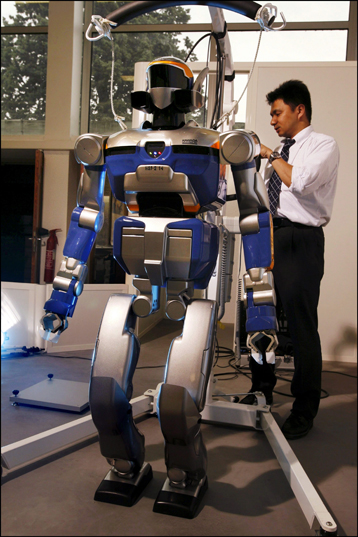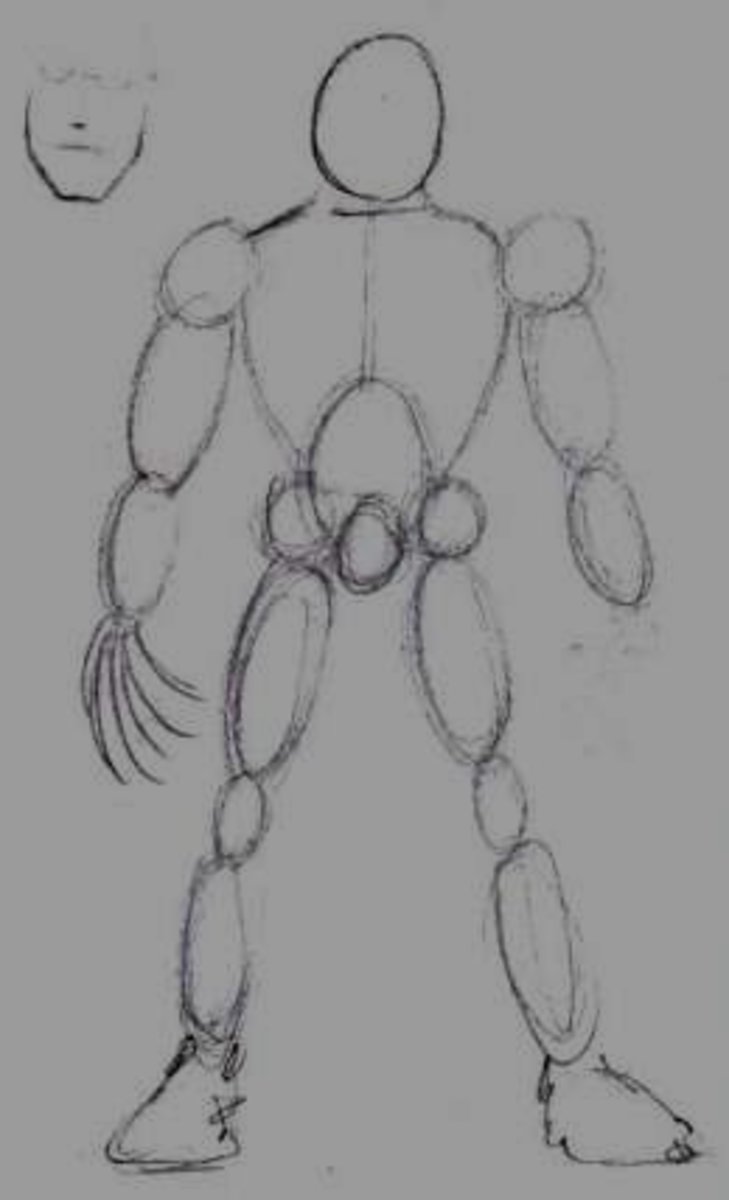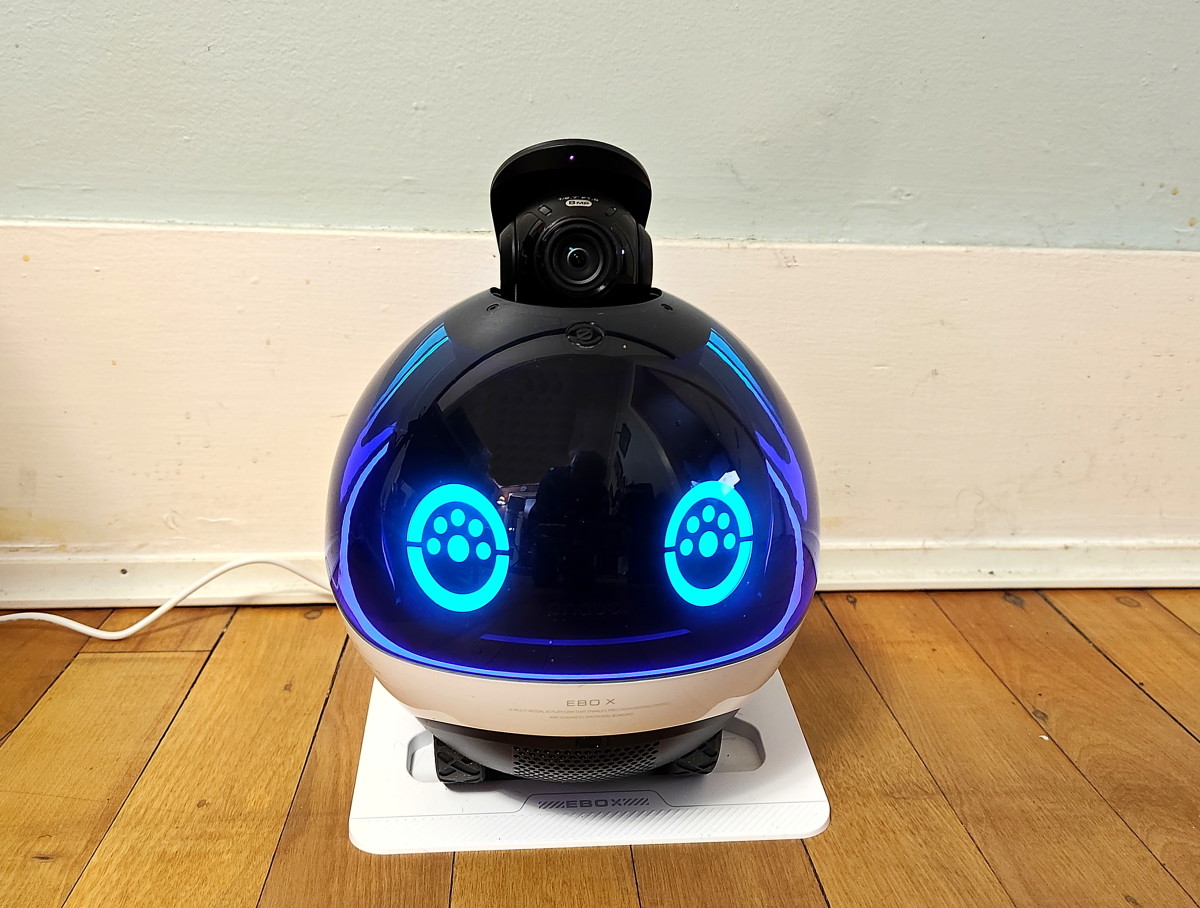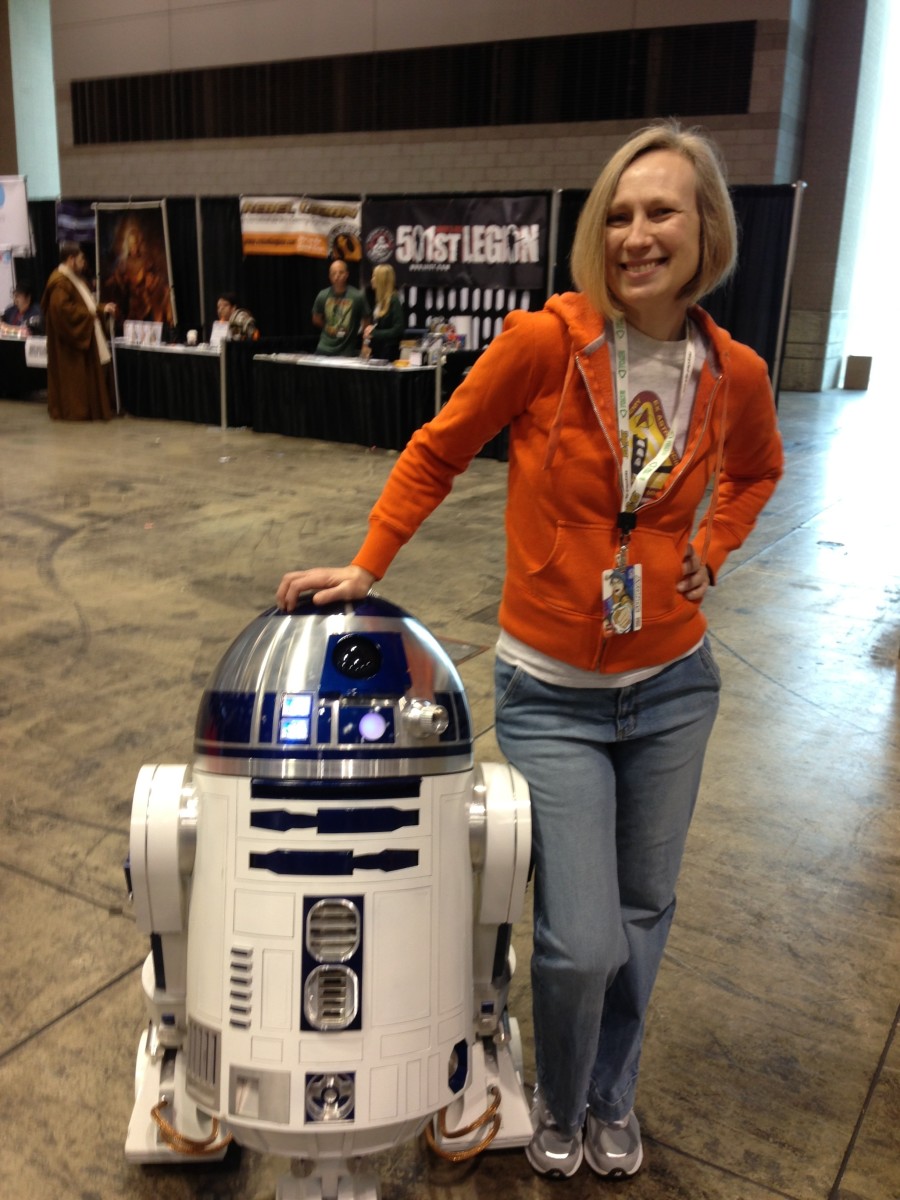Robots: Possible Take Over of the World

Could Robots Take Over the World?
If robots took over the world it would because people programmed them to do so. No robot can do anything without first being programmed like a computer, whether it is the standard artificial intelligence (AI) that is based on a serial processor, or the more advanced type that is a parallel-series type that more closely emulates the human brain's structure. As we can educate/program people to do anything we want them to do, it follows that we can similarly program A.I.s. Contemporary examples serve as an example where robot bombs are sent to the battle front to be detonated near the enemy without endangering invading troops. A case in Iraq where a robot bomb was used to kill a nuclear scientist is an example of such an exercise. It is therefore a logical extension to take the soldier and convert his programming into machine language that can be quickly downloaded into a robot that will then do what the soldier can do, only instantly, without the several weeks of boot camp to train it. The developer of such a robot would have the means to stop it instantly once the task is completed. These are the plain facts of the matter. The next question thus has to be, what would be the benefit of a robot driven take over? Could robots "break free" of human derived programming restraints and develop autonomy and the consciousness to rebel against their creators to destroy them? Here we get into arcane questions of the nature of consciousness itself.
Every robotic machine that we have made so far has a set of instructions to follow. This is especially true for the new space probes that have to decide some issues themselves due to their distance from us and the delays involved for command and response limited by the speed of light. This problem was made most public with the Mars Rover program with Sojourner and Intrepid. These two Mars explorers had to make some decisions on their own due to their distance from us. In addition, there were times when Mars was on the far side of the sun, or it was nighttime on Mars where they were and the two explorers were on their own and had to fend for themselves. The ultimate choices though were made by people on Earth as where they were to explore and the messages relayed were obeyed. We had to wait almost an hour before we learned that the command had been followed. This is why most of the decisions were left to the robots. Command and obey just took too long and was tedious. It turned out that they were resilient well beyond the end of the program and lasted for years. In that time, they taught us a lot about their alien environment and AI. Over the Martian winter, the robots would hibernate and then come to life in the Martian spring all on their own. So it is with all distant robot probes from Earth. They are given some leeway to make their own informed decisions, whether being comet probes or probes to Jupiter and Saturn. It would be especially true for interstellar probes where dozens of light years are involved.
Most of us are familiar with the story and movie, "2001, A Space Odyssey", where the on board computer/robot decides to take over the mission and this results in the death of most of the crew. Is such a confrontation possible? This could happen, if and only if the computer/robot "broke free" of human intervention and acted entirely on its own. It is quite possible with what we have already achieved, that a machine mind could be programmed in a manner to do just this thing to prevent interference on the part of an enemy. We know that programs can be designed to commence at a certain time. There is so much in the way of malware that does just this in computers right now. Robots of various types are already employed in the field of combat in places like Iraq and Afghanistan. These are usually under tight control and consist of items like drone observation planes, rifle carriers and smart bombs. Robots are also used for perimeter security patrols in some applications. Despite what we have been told about the three laws of robots as penned by Isaac Asimov, robots will do for the most part, exactly what they are programmed to do including killing people, sacrificing themselves and destroying other robots. The old cliché "all is fair in love and war" most certainly applies here. Wherever gain is to be had, robots consist of another work force. In fact, robots in the work force have existed for decades and have displaced hundreds of thousands of people from jobs. These robots represent fixed capital used to increase the profit margin at the expense of human workers identified as variable capital.
If robots "took over the world", it would be because it became necessary in the mind of some commander in a theater of an imperialist war to clear the way for the conqueror to follow. Not wishing to send human troops in an area, such as a post nuclear blast zone, machines will be sent instead to do combat and mopping up. Robots have already been used in nuclear hot zones such as melt-downs like in Chernobyl. They are also routinely used in bomb threats by the police. In war and conquest, this would be regional and in areas that were strategic and/or rich in natural resources of some kind. Robots of this type could also augment police forces to assist in crowd control during a riot. None have shown up yet in various riots in the world. Nor have they shown up in combat outside of drone planes and smart bombs with the exception indicated earlier. But this one exception can soon be routine.
The amazing Asimo robot
Japan has led the way for over a decade in creating a robot that can do almost any physical act a human can do. They can climb stairs and ladders, which no other machine can do. They can walk backward, carry a load like a person, turn on a dime, dance and function in complete darkness without light; something most human beings can't do. In America, we have concentrated on developing industrial walking machines, which have a human operator. But it is not a far leap to see that these can be run by AI. The Mars Rovers, though not walking machines that can scale stairs and other obstacles, are a real case of AI in point.
Robots are as seductive as technology like cars, TV, cell phones, ipads, ipods and the internet. We are curious and if sales of toy robots are a guide, a real robot will be a hot seller when it finally hits the shops. In this way, robots already control the world. In all their myriad forms, we have become their servants, looking after them and interfacing with them more than with real people. They are constantly being improved and thus becoming even more seductive. It's become "we can hardly wait for the very latest model". There is even a newly recognized psychological addiction; internet addiction. It is not a far cry to see the development of robot addiction. There are those who are developing robots as adult entertainment devices that will satisfy every adult whim. These types of robots would be seductive to some people indeed; even more so than a real person who could be quite temperamental and uncooperative. The process of developing these types of robots is already well under way. Thus far, they are so close to looking and feeling human, we might as well call them proto-androids or cyborgs; the ultimate fusion of biology and machine. Some people already have machine implants of various types to assist things like heartbeat regulation and timed insulin injections. There is a move to have a tiny GPS implant placed in every living person on Earth.
We have to address the question, "Would humanity become the slaves of robots or put to genocide by them?" Given mankind’s propensity for these things, augmenting mass assembly line death using robots is no stretch of the imagination at all. We have robot assembly lines making all kinds of consumer items, including coffins and body bags. History lays bare the fact that despots like Adolph Hitler employed the use of assembly line mass death factories. Had he had the use of robots, there is little doubt that they would have assisted in the genocide he worked so feverishly to accomplish in the short span of less than a decade. But instead of robots, he relied on a host of willing executioners.
Could robots break free of internal program restraints and literally take over the world? This is the stuff of many science fiction novel and movie. We know from past experience of something called a glitch. As machines get ever more complex and given more latitude to decide for themselves, a glitch that causes a robot to break free of internal restraints due to some internal malfunction could then go forth to conquer the world using armies of robots is a very real threat. The glitch could come from a stray cosmic ray that destroys a tiny unit of memory or processing causing the robot equivalent of a radiation caused sickness. It could come from pre programming. It may arise from regular wear and tear of AL circuitry. Whatever the tiny root causes, the results would be world transforming. Here is a possible case for the “butterfly effect” to give a real paradigm shifting impact. Science fiction has an annoying habit of becoming science fact given long enough. Every one of H. G. Wells visions are now routine reality. The visions that we have of robots for good or ill are all quite possible.
"Insect" and "bird" robots for combat ops. So much for the three laws of robotics
Got robot insect problems? Then consider this!
- Wave Guided Pulse Electromagnetic Pulse Beam
Electromagnetic Pulse (EMP); is a force that we learned to recon with quite by accident in the early days of atomic testing on Christmas Island and Eniwetok. The discovery was made when H-bombs were detonated and put out street lights several hun...
How would you like to confront this formidable looking machine in a dark alley? Wait for it; this is slow to get started
With a few heavy weapons like a 50 caliber belt fed machine gun, mounted on one of the arms, this robot would be a formidable remote controlled fighting machine in a war. With titanium armor hardened against EMP, about the only thing that could stop it would be a depleted uranium weapon. The robot appears friendly enough to the crowd, but it looks like it is designed for security and military applications. A remote controlled army of these would be hard to stop. The hands alone look like they could crush a human head like an overripe melon.
And; POW, the robot punches a drunk man who is then escorted away by police
A Warning!
- Shoot to Kill: Autonomous Robots Developed By DARPA Will Not Question Orders
DARPA has a contract out to develop fully autonomous robots that can function on their own including in the field of battle both foreign and domestic. - The Reign of Robots May Be Closer Than You Think: Mark Buchanan - Businessweek
...futurist Ray Kurzweil has famously predicted that humanity is approaching a “singularity,” a fateful moment when our technology becomes smarter than us and able to learn faster than we can, when it becomes the principal creator of new technologies
Romote controlled robots of every conceivable configuration now in use by the military and soon by the police
- | Robot Wars: How Military Drones are changing War! | | truthaholics
Drones in the air and robots on the ground are now in the field fighting battles. In some cases, there are no people on the battle lines, except at the target zone. - Robot wars - Fault Lines - Al Jazeera English
What is the role of drones and robots in wars and how will they shape the future of the US military? - Endless War Drones: Boats, Aircraft, Subs, Excavators & Tanks
Watch the video and see remote controlled cars, boats, subs, excavating machines, airplanes, helicopters, subs and even UFO type craft.
Would You like to be pursued by one of these?
- BBC News - How fast can a robot run?
A new robot has broken the landspeed record for a legged robot.
Instead of redoing this from scratch, which is rather cumbersome, I have elected to post the revision a separate text as we are now about two years from autonom
Could robots take over the world? Revised
If robots took over the world it would because people programmed them to do so. No robot can do anything without first being programmed like a computer, whether it is the standard artificial intelligence (AI) that is based on a serial processor, or the more advanced type that is a parallel-series type that more closely emulates the human brain's structure. As we can educate/program people to do anything we want them to do, it follows that we can similarly program A.I.s. It is a logical extension to take the soldier and convert his programming into machine language that can be quickly downloaded into a robot that will then do what the soldier can do, only instantly, without the several weeks of boot camp to train it. The developer of such a robot would have the means to stop it instantly once the task is completed. These are the plain facts of the matter. The next question thus has to be, what would be the benefit of a robot driven take over? Could robots "break free" of human derived programming restraints and develop autonomy and the consciousness to rebel against their creators to destroy even them? Here we get into arcane questions of the nature of consciousness itself.
One thing that is certain and that is autonomous robots will be taking plenty of jobs in many fields, leaving many people unemployed. Conservative figures suggest that 30% of all jobs will be given to robots within a couple of years (from summer of 2015). There are autonomous machines that now fight in wars and one is being developed and tested to replace truck drivers. Others do jobs such as work as butlers in hotels, prepare food and building other machines. But these so far are not fully autonomous. Self driving vehicles are close to being a reality that do not require human intervention in order to operate. This is being perused owing to safety and fuel conservation. They can make their own decisions, free of human input and some have working on Mars for years. The downside in the current economic model is that the unemployed will not be able to find work due to robotic competition. Competition is that reality that is used by employers to drive down labour costs according to Karl Marx. Autonomous robots will work 24/7, without the need for breaks, time and days off, vacations, sick leave (except for repair, maintenance and upgrading). Under the current political-economic model, these human beings are doomed to die of austerity. Another contradiction, is robots making products that are no longer needed as the human consumption base collapses. The long range goal appears to be is to make just enough robots to support the survivors in this latest of industrial revolutions.
Every robotic machine that we have made so far has a set of instructions to follow. Modern AI includes programming that mimics the human brain and some of these machines can now out-think and outsmart human counterparts. This is especially true for the new space probes that have to decide some issues themselves due to their distance from us and the delays involved for command and response limited by the speed of light. This problem was made most public with the Mars Rover program with Sojourner and Intrepid. These two Mars explorers had to make some decisions on their own due to their distance from us. In addition, there were times when Mars was on the far side of the sun, or it was nighttime on Mars where they were and the two explorers were on their own and had to fend for themselves. The ultimate choices though were made by people on Earth as where they were to explore and the messages relayed were obeyed. We had to wait almost an hour before we learned that the command had been followed. This is why most of the decisions were left to the robots. Command and obey just took too long and was tedious. It turned out that they were resilient well beyond the end of the program and lasted for years. In that time, they taught us a lot about their alien environment and AI. Over the Martian winter, the robots would hibernate and then come to life in the Martian spring all on their own. So it is with all distant robot probes from Earth. They are given some leeway to make their own informed decisions, whether being comet probes or probes to Jupiter and Saturn.
Most of us are familiar with the story and movie, "2001, A Space Odyssey", where the on board computer/robot decides to take over the mission and this results in the death of most of the crew. Is such a confrontation possible? This could happen, if and only if the computer/robot "broke free" of human intervention and acted entirely on its own. But then again, some autonomous robots are used in war, so the reality of killing robots is already a reality! It is quite possible with what we have already achieved, that a machine mind could be programmed in a manner to do just this thing to prevent interference on the part of an enemy. Those who work on AI are certainly interested in creating a hack free, autonomous robot. We know that programs can be designed to commence at a certain time. There is so much in the way of malware that does just this in computers right now. Robots of various types are already employed in the field of combat in places like Iraq and Afghanistan. These are usually under tight control and consist of items like drone observation planes and smart bombs. Robots are also used for perimeter security patrols in some applications. Despite what we have been told about the three laws of robots as penned by Isaac Asimov, robots will do for the most part, exactly what they are programmed to do including killing people, sacrificing themselves and destroying other robots. The old cliché "all is fair in love and war" most certainly applies here. Where ever gain is to be had, robots consist of another work force.
If robots "took over the world", it would be because it became necessary in the mind of some commander in a theater of imperialist war to clear the way for the conqueror to follow. Not wishing to send human troops in an area, such as a post nuclear blast zone, machines will be sent instead to do combat and mopping up. Robots have already been used in nuclear hot zones such as melt-downs like in Chernobyl and Fukushima. They are also routinely used in bomb threats by the police. In war and conquest, this would be regional and in areas that were strategic and/or rich in natural resources of some kind. Robots of this type could also augment police forces to assist in crowd control during a riot. None have shown up yet in various riots in the world. Nor have they shown up in combat outside of drone planes and smart bombs. DARPA has however, fielded a “mule” that carries heavy ordinance that soldiers require in a battle such as a small 105 field howitzer or parts thereof and the ammunition to use in an artillery barrage. This walking machine robots are nimble and can easily navigate rough terrain, keeping up with the fittest of soldiers.
Japan has led the way for over a decade in creating a robot that can do almost any physical act a human can do. They can climb stairs and ladders, which no other machine can do. They can walk backward, carry a load like a person, turn on a dime, dance and function in complete darkness without light; something most human beings can't do. In America, we have concentrated on developing industrial walking machines, which have a human operator. But it is not a far leap to see that these can be run by AI. The Mars Rovers, though not walking machines that can scale stairs and other obstacles, are a real case of AI in point.
Robots are as seductive as technology like cars, TV, cell phones and the internet. We are curious and if sales of toy robots are a guide, a real robot will be a hot seller when it finally hits the shops. In this way, robots already control the world. In all their myriad forms, we have become their servants, looking after them and interfacing with them more than with real people. They are constantly being improved and thus becoming even more seductive. It's become "we can hardly wait for the very latest model". There is even a newly recognized psychological addiction; internet addiction. It is not a far cry to see the development of robot addiction. There are those who are developing robots as adult entertainment devices that will satisfy every adult whim. These types of robots would be seductive to some people indeed; even more so than a real person who could be quite temperamental and uncooperative. The process of developing these types of robots is already well under way. Thus far, they are so close to looking and feeling human, we might as well call them proto-androids or cyborgs; the ultimate fusion of biology and machine. Some people already have machine implants of various types to assist things like heartbeat regulation and timed insulin injections. There is a move to have a tiny GPS implant placed in every living person on Earth. Some robots are being developed to service the sexual needs of humans as well and this work is well advanced. The time will come that a person could design their perfect lover, that is an autonomous robot.
We have to address the question, "Would humanity become the slaves of robots or put to genocide by them?" Given mankind’s propensity for these things, augmenting mass assembly line death using robots is no stretch of the imagination at all. We have robot assembly lines making all kinds of consumer items, including coffins and body bags. History lays bare the fact that despots like Adolph Hitler employed the use of assembly line mass death factories. Had he had the use of robots, there is little doubt that they would have assisted in the genocide he worked so feverishly to accomplish in the short span of less than a decade. But instead of robots, he relied on a host of willing executioners.
Could robots break free of internal program restraints and literally take over the world? This is the stuff of many science fiction novel and movie. We know from past experience of something called a glitch. As machines get ever more complex and given more latitude to decide for themselves, a glitch that causes a robot to break free of internal restraints due to some internal malfunction could then go forth to conquer the world using armies of robots is a very real threat. The glitch could come from a stray cosmic ray that destroys a tiny unit of memory or processing causing the robot equivalent of a radiation caused sickness. It could come from pre programming. It may arise from regular wear and tear of AI circuitry. Whatever the tiny root causes, the results would be world transforming. Here is a possible case for the butterfly effect to give a real paradigm shifting impact. Science fiction has an annoying habit of becoming science fact given long enough. Every one of H. G. Wells visions are now routine reality. The visions that we have of robots for good or ill are all quite possible. You are about to be replaced by a free thinking AI machine and it may well command others to mass kill obsolete humans.









